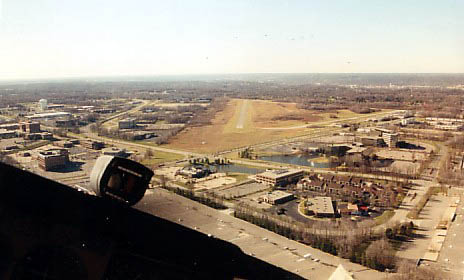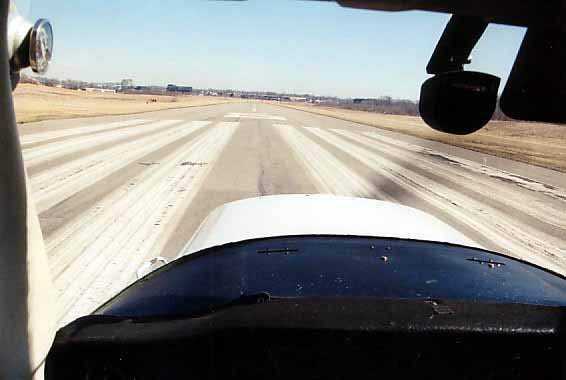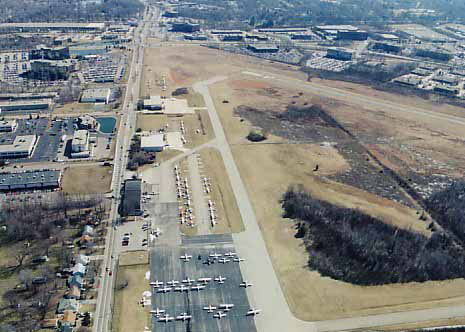


Blue Ash airport is located six miles northeast of downtownCincinnati at the intersection of Pfeiffer and Reed-Hartman Roads. It is a small 226-acre general aviation airport that serves mostly smallrecreational and business aircraft. It is an "uncontrolled airport",meaning that there is no operating control tower on the field meaning pilotsbroadcast their intentions over a radio frequency when arriving or departingthe field. The airport is owned by the City of Cincinnati, whichprovides maintenance and receives Federal Funding for the airport, whichis one important reason the City has resisted its sale to private interests. The airfield is surrounded by corporate business parks on all sides; somestand just feet from the single 3,500 foot runway. Almost annuallythere is discussion to sell part or all of the airfield to generate moretax base for the city. Just west of the airfield on Cooper Rd. sitsthe Cincinnati-owned Blue Ash Golf Course on land planned for airport expansion.
The airport was originally known as Grisard Field andwas founded in 1921 by the Grisard Company (partially owned by EshelbyLunken) in an attempt to lure lucrative Federal funds and airmail routesto Cincinnati. It also housed the 359th Army Reserve ObservationSquadron. The airfield was commercially leased the next year to brothersHugh and Parks Watson and it became a favorite place to visit for weekendairplane rides and flying circus air shows.
In 1925, Eshelby Lunken and the Grisard Company sold theBlue Ash airfield to the Watson brothers. Grisard Field now became WatsonField. The Grisard Company had eyes on the small airfield locatednear the Ohio River on what was then called the Turkey Bottoms, later tobecome known as Lunken Airport. After the 1937 flood completely submergedLunken Airport, Cincinnati civic leaders reconsidered the Blue Ash airportas the most promising location. Starting in 1938, Cincinnati politicians,civic leaders and others fought with each other in attempts to build alarge commercial airport for the City of Cincinnati at the Blue Ash location. Through the years, failed bond issues, political in-fighting and disagreementsfailed to produce any firm decision on building at the Blue Ash location. Meanwhile, Northern Kentucky politicians were successful in winning Federalapproval and were awarded funds to build what would eventually become theCincinnati/Northern Kentucky International airport. The Watson brotherssold the Blue Ash airport to the City of Cincinnati in 1946 and the airfieldwas renamed the Blue Ash airport. Throughout the 1950s, there werestill political efforts to build the "Cincinnati Airport" in Blue Ash butBlue Ash civic leaders and residents fought any major airport redevelopmentissues. As time went by, suburbs and businesses expanded and anychance for Blue Ash to become the site of a major airport dwindled.


Blue Ash today maintains the rustic yet modern charm thatis a small and friendly general aviation airport. Summer air showsare still held there annually and many attend flight training and chartersmall aircraft out of Blue Ash for weekend jaunts. Pilots can usuallybe found hanging around the lounge engaged in "hangar flying" discussions,and although one can literally walk out of any of the hangar and see newlybuilt business and residences directly across the street, the city hasaccepted the airport as an old friend and all accept each other peacefully.
Blue Ash air operations can be monitored on scanner frequency123.0.
For more Blue Ash Airport statistics, ClickHere
1. Cincinnati/NorthernKentucky International Airport
2. LunkenAirport
3. BlueAsh Airport